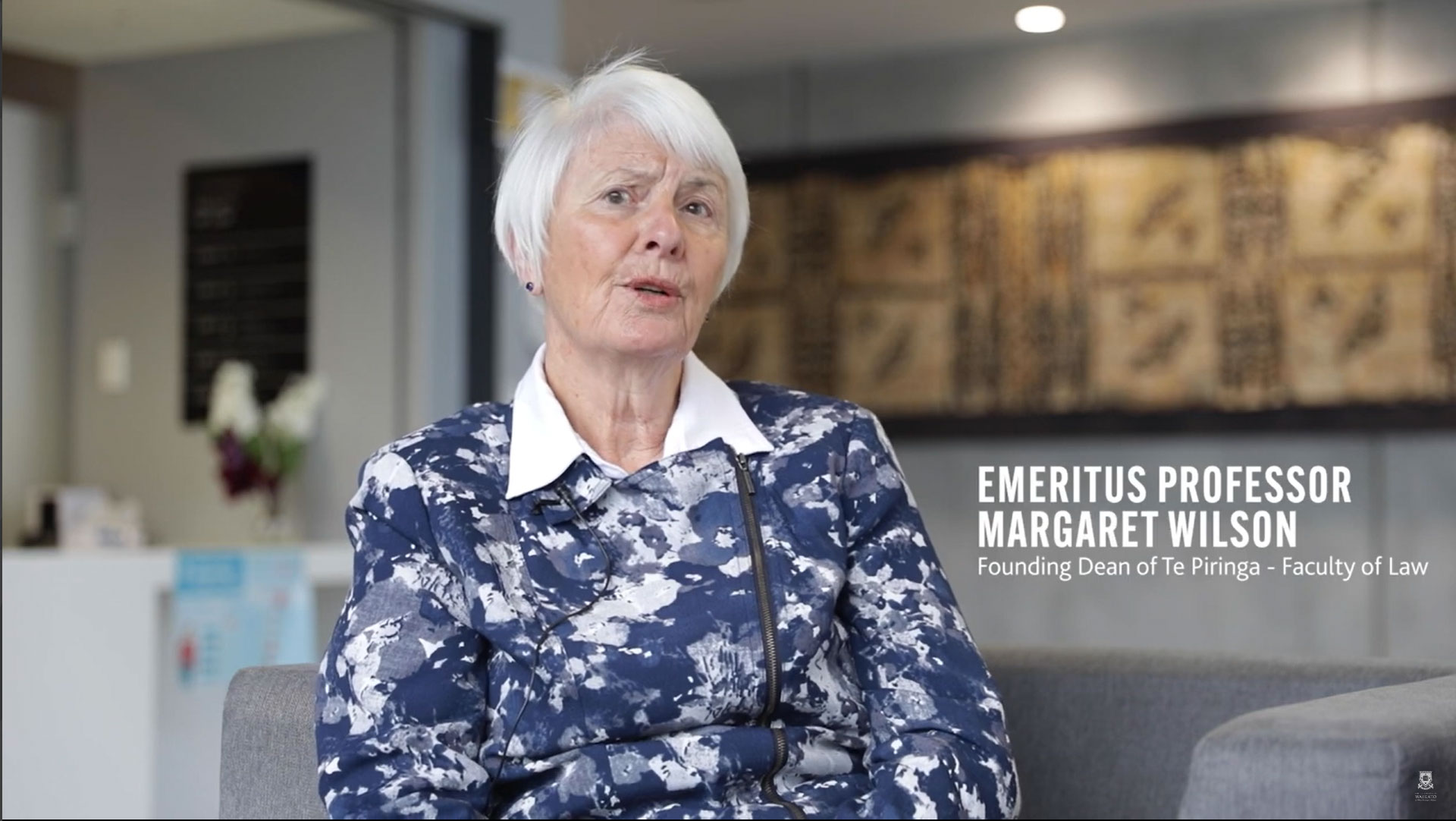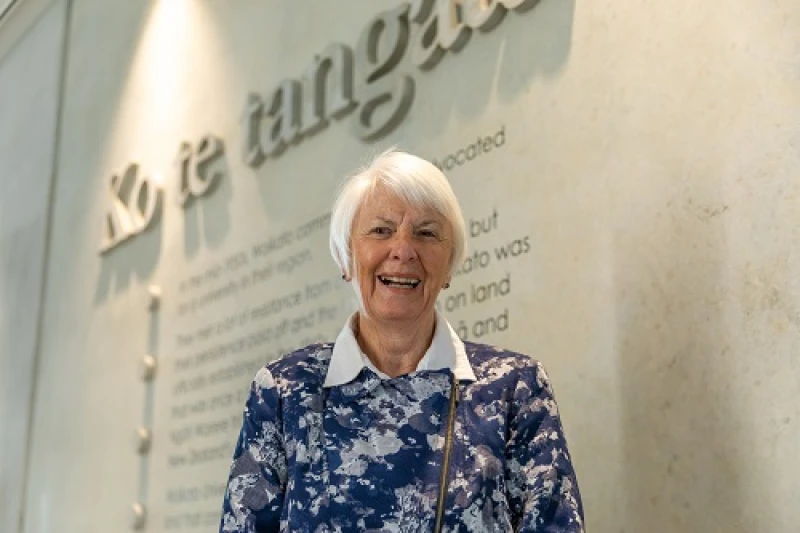History of the Law School
Discover the establishment of Te Piringa - Faculty of Law at University of Waikato. Founding Dean, Emeritus Professor Margaret Wilson, shares insights.
The Founding Dean, Emeritus Professor Margaret Wilson, talks about those early years.

Professor Wilson was the founding Dean of Law at Waikato University from 1990 to 1994, then moved into research and teaching roles until 1999, before moving into a series of ministerial roles in Parliament. She returned to Te Piringa as a professor in 2009, then retired in 2019.

Getting started
When reflecting on the impetus for setting up a new law school at Waikato, Professor Wilson says the push came from several directions.
A group of Hamilton lawyers, backed by Waikato-Tainui and the late Sir Robert Mahuta were key players.
“They all believed there should be an opportunity to study law at Waikato University, and they were a very effective lobby group,” recalls Professor Wilson.
“There was also a feeling from inside the judiciary, and [former High Court judge] the late Sir Ivor Richardson, that it was time for a different approach to legal education.”
Lobbying eventually led to the Government to set up a fourth law faculty at the University of Waikato.
“It was a contestable process - Massey lobbied for it along with Waikato - and the Government awarded the capital funding for a new law school to Waikato”.
Challenging times
Professor Wilson was appointed the Dean in 1990, and stayed in the role for several years while the Faculty of Law was established at Waikato.
However, those early years proved challenging. A change in government and a change in policy in funding tertiary institutions saw capital funding removed from the Waikato law school in 1991.
“It was difficult for the university, but our Vice-Chancellor at the time, the late Wilf Malcolm, and a group of local lawyers led by former mayor, the late Ross Jansen, lobbied the Government and we rescued about $1 million,” recalls Professor Wilson.
With strong student interest and operational funding, based on the number of enrolled students, plans for the law school continued.
“We started in 1991 and I don’t think it’s looked back.”
Demand for Waikato law school
With around 1000 applications before the Faculty of Law had even opened, “there was a genuine need at the time”, not only from the Waikato and Bay of Plenty region, but further afield including Tairāwhiti (Gisborne) and north of Auckland.
“The University provided students with the opportunity to study law that wouldn’t have been available but for setting it up,” says Professor Wilson. “That was the most important thing for me. For many students going to Auckland, Victoria, Otago or Canterbury wasn’t a practical option.
The central University campus, with its on-site accommodation and supportive culture, was appealing to those from smaller towns and Māori and Pacific communities.
The name Te Piringa was gifted to the Faculty by the late Māori Queen, Te Arikinui Dame Te Atairangikaahu. It translates as “the coming together of peoples and cultures”.
Around 150 Waikato law students began in 1991.
“We only had a small number of places, because we had to be careful bringing it on,” recalls Professor Wilson. “We had to get staff, and it takes time to set these things up.”
They were a diverse group, not only from a variety of cultural backgrounds, but a diversity of ages and life stages.
“We had really good applicants,” recalls Professor Wilson, of the first law cohort. “At the time, New Zealand society was going through a lot of redundancy through restructuring, and we attracted a lot of people changing jobs and requalifying, so that initial student body for the first few years was incredibly diverse which was good.”
Taking a new approach
Being a new school gave them the license to be creative and innovative.
“We had enormous freedom … and we had a very different approach. We placed an emphasis on the quality of teaching. We were the first law school to have a computer lab.”
One of Te Piringa’s key pillar’s was a bicultural approach to law education. This, and a programme funding Pacific students, attracted a large number of Māori and Pacific students.
“Since those early days, Māori and Pacific students have been very important to Te Piringa, reflected in the graduates, alumni and research in these communities from Waikato University,” says Professor Wilson.
“We also had an emphasis on supporting not only Māori, but women, and those coming back to retrain. There was a strong feminist perspective that ran through the curriculum, which some may have found threatening, but some of those women now lead law firms of course.”
The first graduation in 1994 “was wonderful”, and after six months of professionals, seeing “the first admissions to the profession was a big moment for the law school,” recalls Professor Wilson.
Te Piringa’s founding three pillars
Founding Dean, Emeritus Professor Margaret Wilson, says the three pillars were important to the shape and direction of the law school in 1991.
“Because we were new, we had the opportunity to set out what our foundation principles would be,” says Professor Wilson. “Firstly, professionalism. We knew we had to produce good lawyers who understood the legal system and legal rules so they could practice law. Because that’s why most people do a law degree, they want to get a job.
“Secondly, we had a commitment to a bicultural approach to legal education. We were the first law school to introduce into our mainstream legal programmes, a Māori perspective.
“And third, and as important in my view, we said we were going to teach law in context. We weren’t only going to teach rules, but we were also going to teach how rules are made and how they can be changed and what the social and economic context was for legal regulation. And that was a distinguishing feature of Waikato. Subsequently, I think some other law schools have incorporated some of what we were initiating at that time.”
Professor Wilson said that Waikato University Law Faculty led the way from the very start.
“We really pioneered dispute resolution.
“It’s important that people know what their legal rights are and how they can get remedies, but going to court isn’t always the best way to get legal resolution; you can do it through mediation or adjudication, so we had that structured into the degree from early on.”
A Waikato law degree would also be practical and versatile, designed as a foundation for a variety of careers.
“The intention was also to provide students with legal skills, but for students to not necessarily get jobs in law offices in a traditional sense,” says Professor Wilson. “The statistics said that about one third of people that got law degrees didn’t end up in law offices, they did other things. We were providing students with a range of skills they could use in all sorts of occupations. And that’s what happened.”
An innovative structure also enabled Waikato law students to do integrated, conjoint degrees - law and management, and law and social sciences, were popular combinations. Professor Wilson estimates that around 50 per cent of law students do conjoint degrees at Waikato.
Even today, the three pillars are a vital part of Te Piringa.
“Our three founding pillars are unique and have continued to serve us well,” says Professor Alpana Roy, current Dean of Law at Waikato University.
“The three pillars of biculturalism, professionalism and the study of law in context is something that we take seriously. It’s in our DNA. Many organisations have a mission, but usually it’s just words. But here, it is something you see embedded in our curriculum, in our vision, our research, our teaching, our engagement, and our student body. These core principles are something our academics go back to again and again.”
“Biculturalism was something that Te Piringa pioneered 30 years ago, and it will always be one of our foundation principles,” says Professor Roy. “Biculturalism and tikanga Māori will continue to be embedded in our law programme.
“Our genuine commitment to biculturalism is mirrored by the fact we have one of the largest cohorts of Māori and Pacific students in the country..
“Those three founding pillars are as relevant today as back when we were founded in 1991, in fact they seem to have become stronger. The three pillars of biculturalism, professionalism and the study of law in context is what makes us genuinely unique and will stand the test of time.”
The carved paepae
 This carved paepae was a personal gift from Te Arikinui Dame Te Atairangikaahu to the university and the Law School.
This carved paepae was a personal gift from Te Arikinui Dame Te Atairangikaahu to the university and the Law School.
The timber for this piece of carving came from the tahahi (ridgepole) of the whare whakairo (meeting house) at Waahi,which was originally carved by Patara Te Tuhi for Tāwhiao,the second Māori King. When the house was dismantled in 1965, the totara timber was put in storage for some years.
This carving was started in 1981 and completed in 1985 at Waahi Pa. Supervision of this project was undertaken by one of Tainui’s master carvers, Taonui-a-Kupe Rickard. This carving comprises eight main figures representing the sacred canoes which sailed to Aotearoa in 1 350AD.
From east to west, the first figure represents Te Arawa, the second Mātaatua, the third Tākitimu, the fourth Tokomaru, the fifth Kurahaupé, the sixth Aotea. The seventh is Ngatokimatawhaorua and the eighth, Horouta. At the east end of the Rākau is the face of a mānaia welcoming the coming of a new day. The mandia at the west end faces the setting sun and pays homage to the day's end as evening approaches. The whole Rakau represents Tainui welcoming, embracing and giving full support, blessing and last but not least giving assurance to the descendants of the sacred canoes represented. The small figurehead in the centre of the Rākau represents the descendants of all those canoes and the young generation of tomorrow who will enter this Law School to search, to seek, to find, to question, to learn and to further their knowledge. The background interlinking the manaia coincides with the whakapapa (genealogy) of the sacred canoes. It links, it binds, strengthens and uplifts the kaupapa (principles) on which the Law School is founded.
The name of the carving is Te Rākau Kotahi. Literally this means ‘the one tree’ but refers to ‘the tree of knowledge’ or ‘the tree of wisdom’ tree of unity, in all of its aspects, one of the most powerful and central conceptual values of the Maori ethos, combining all the strands and components of history, time and culture of all the peoples of Aotearoa.
The carving was moved to the new building sunken courtyard on the Management side of the building.